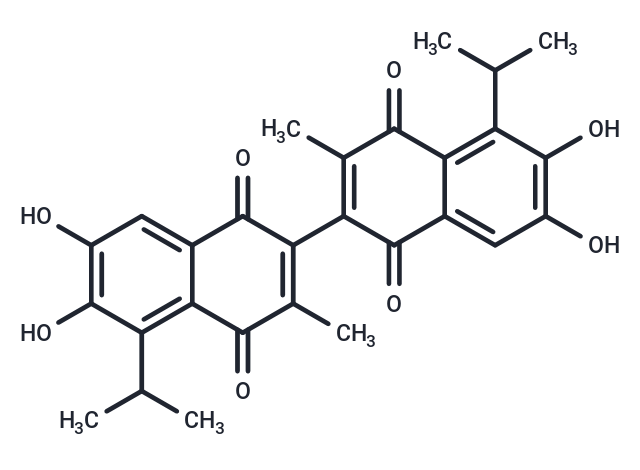Shopping Cart
Remove All Your shopping cart is currently empty
Your shopping cart is currently empty
Apogossypolone (ApoG2) is a semi-synthesized derivative of gossypol which is a nonpeptidic small molecule inhibitor targeting Bcl-2 family proteins with K i values of 35, 25 and 660 nM for Bcl-2, Mcl-1 and Bcl-X L, respectively. Apogossypolone shows antitumor activities, induces cell apoptosis [1] and autophagy [2]. Apogossypolone also has antifungal activity [3].

| Pack Size | Price | USA Warehouse | Global Warehouse | Quantity |
|---|---|---|---|---|
| 25 mg | $1,520 | 6-8 weeks | 6-8 weeks | |
| 50 mg | $1,980 | 6-8 weeks | 6-8 weeks | |
| 100 mg | $2,500 | 6-8 weeks | 6-8 weeks |
| Description | Apogossypolone (ApoG2) is a semi-synthesized derivative of gossypol which is a nonpeptidic small molecule inhibitor targeting Bcl-2 family proteins with K i values of 35, 25 and 660 nM for Bcl-2, Mcl-1 and Bcl-X L, respectively. Apogossypolone shows antitumor activities, induces cell apoptosis [1] and autophagy [2]. Apogossypolone also has antifungal activity [3]. |
| Targets&IC50 | Bcl-xL:660 nM (Ki), MCL1:25 nM (Ki), Bcl-2:35 nM (Ki) |
| In vitro | Apogossypolone (ApoG2) demonstrates enhanced stability under stressed conditions and exhibits a range of antitumor activities. At concentrations ranging from 0 to 1 μM over periods of 72 to 96 hours, it inhibits the growth of WSU-DLCL 2 cells in a dose-dependent manner. Furthermore, between 0 to 5 μM, and over 24 or 48 hours, it disrupts the interaction between anti-apoptotic and pro-apoptotic members of the Bcl-2 family, consequently activating the cleavage of caspase-3, caspase-9, and PARP. Additionally, doses of 0 to 8 μM applied from 0 to 72 hours prompt apoptotic cell death in WSU-DLCL 2 cells, showing both time and dose-dependency. At higher concentrations of 0 to 10 μM during a span of 0 to 24 hours, ApoG2 triggers autophagy and enhances reactive oxygen species (ROS) production in HCC cells. In various assays, ApoG2 has been shown to inhibit cell growth, block critical protein interactions, induce apoptosis, and stimulate autophagy in a manner that is dependent on both the dose and duration of treatment, highlighting its potential as a therapeutic agent in cancer treatment strategies. |
| In vivo | Apogossypolone (ApoG2) administered at a dosage of 120 mg/kg, either intravenously (i.v.) or orally (p.o.), once daily for five days, has been demonstrated to effectively inhibit the growth of diffuse large cell lymphoma cells in Four-week-old female ICR-SCID mice, without exhibiting toxicity. In this study, each mouse received 10^7 WSU-DLCL2 cells (in serum-free RPMI 1640) subcutaneously (sc) in the flank areas. The treatment not only inhibited the growth of WSU-DLCL2 cells but also significantly reduced tumor weight. Additionally, in a separate study, non-tumor-bearing SCID mice administered with up to 800 mg/kg of the compound showed no gross signs of toxicity, indicating a high tolerance to ApoG2. |
| Molecular Weight | 490.5 |
| Formula | C28H26O8 |
| Cas No. | 886578-07-0 |
| Smiles | C(C)(C)C1=C2C(C(=O)C(=C(C)C2=O)C=3C(=O)C=4C(C(=O)C3C)=C(C(C)C)C(O)=C(O)C4)=CC(O)=C1O |
| Relative Density. | no data available |
| Storage | Powder: -20°C for 3 years | In solvent: -80°C for 1 year | Shipping with blue ice/Shipping at ambient temperature. |
| Size | Quantity | Unit Price | Amount | Operation |
|---|

Copyright © 2015-2026 TargetMol Chemicals Inc. All Rights Reserved.